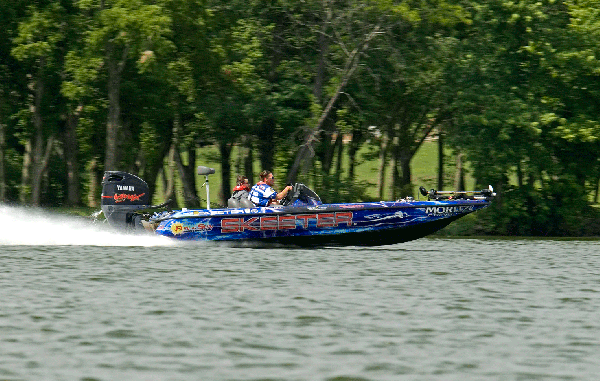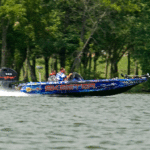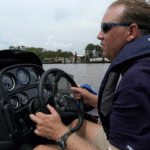
PFDs first line of defense to stay safe
April in the South heralds spring and the beginning of boating season. It is that time of year when Louisiana’s 320,000 registered boats are on our waterways, serving as platforms for all sorts of recreational and commercial activity. Fortunately, we have plenty of room for boaters all over the state. Inland waters cover 7,409 square miles. Go down to the coast and you will find 1,031 square miles of territorial seas, another 7,721 miles of tidal shoreline and 6 million acres of coastal estuaries.
Boating safety patrol is, indeed, a daunting task for the men and women of LDWF’s Law Enforcement Division. Thousands of man hours are spent monitoring boat traffic and enforcing safety regulations. When agents are out on the water, in addition to enforcement of applicable fish and wildlife regulations, they focus on three aspects of boating enforcement: Safety equipment, safe operation and impaired boat operators.
Without exception, every boat on the water is required to have safety equipment on board. At the very least, even on a paddle- boat of less than 16 feet in length, each person is required to have a serviceable personal flotation device (PFD). We will talk more about PFDs in a bit. From that point, safety equipment requirements increase based on size and configuration of the boat.
Based on length, we have four classification groups for vessels:
• Class A – Less than 16 feet
• Class 1 – 16 feet to less than 26 feet
• Class 2 – 26 feet to less than 40 feet
• Class 3 – 40 feet to less than 65 feet
Depending on the length of your boat and where and when you operate it, safety gear could include fire extinguishers, visual distress signals, sound signaling devices, navigation lights and anchor lights. Go to LDWF’s Web site (www.wlf.louisiana.gov) and click on “Boating” and then “Required Equipment and Regulations,” or pick up a Boating Safety Regulations booklet, for complete information.
For the sake of brevity, we will confine discussion of safety gear to PFDs. Ask any wildlife agent to identify the No. 1 life saver on a boat and the answer without hesitation will be the PFD. It is commonly called “life jacket” or “life vest,” and the name says it all. But in my years of water patrol, I saw lots of folks really missing the boat (bad, I know) where PFDs are concerned.
It is not unusual to find rotted or water-logged PFDs, extra-large adult sizes wrapped around toddlers, PFDs crammed so far into storage compartments they can’t be reached or no PFDs at all. And, by the way, a citation can and will be issued in each of these situations.
The PFDs must not only be on board, but they have to be in good condition, fit properly and be readily accessible. And this is a good time to mention that everyone 16 years of age or younger on board Class A and Class 1 motorboats must wear a PFD while the boat is under way.
Enforcement agents are keen on handling careless or reckless operators, as well. Careless operation of a vessel is defined as “operation of any watercraft in a careless or heedless manner so as to be grossly indifferent to the person or property of other persons or at a rate of speed greater than will permit him in the exercise of reasonable care to bring the watercraft to a stop within the assured clear distance ahead.” Reckless operation is the “operation of any watercraft in such a manner so as to endanger the life or limb or damage the property of any person.” If you are not clear on the difference, think of it this way: A careless operator almost hits the boat dock. Reckless operation is when he does hit the dock ,causing damage or injury.
Can anyone recall a day on the lake when you witnessed one or the other, or maybe both? I’ll bet my favorite PFD we all have, particularly on crowded and congested rivers and lakes. It is not only annoying but a factor in any collision accident involving two or more boats, or a boat and a visible fixed object.
Another factor that contributes to more than half of all boating accidents and fatalities is intoxicated operation. The Law Enforcement Division dedicates significant resources in manpower, training and equipment to the apprehension of impaired boat operators. Information gleaned from statistics on when, where and under what conditions alcohol-related accidents occurred is utilized to schedule patrols. The idea is to put the maximum number of agents on the water during those times when intoxicated operation is most likely to occur and when conditions are ripe for disaster.
It is no great mystery that dusk on a summer weekend afternoon is a prime time for a drunk to cause a boat wreck. Agents schedule patrols on busy waterways during those times and keep a sharp eye on boat traffic, looking for careless operation and impaired operators.
Laws and penalties applied to driving while intoxicated on the street are the same for driving a boat while under the influence. It is also worth mentioning that it is also illegal for the owner of any watercraft or any person in charge or in control to allow or knowingly permit the watercraft to be operated by anyone who is intoxicated or under the influence of drugs.
We will wrap up this edition with mention of some of the relatively new boating regulations, as some readers may not be aware of these changes.
As mentioned earlier, every person 16 years of age or younger on board class A and Class 1 boats must wear a USCG-approved PFD while the boat is underway. Previous to Aug. 15, 2009, the age was 12 and under.
Effective July 1, 2010, no one born after Jan. 1, 1984, may operate a boat powered by a motor in excess of 10 horsepower unless he has successfully completed a National Association of State Boating Law Administrators-approved boating safety class. Proof of course completion must be in possession when operating such a boat.
DWI penalties now include suspension or revocation of boating privileges when a person loses driving privileges due to suspension or revocation of their license due to a DWI. It does not matter whether the offense took place in a vehicle or a watercraft.
Two recent requirements for hand-tiller outboards make it mandatory for all persons onboard Class A motorboats to wear a USCG-approved Type I, II, III or V PFD while under way. The other requirement is that an engine cut-off switch be attached to the operator when the engine is running on outboards in excess of 10 horsepower. There is an exception for commercial fishermen.
Finally, those engaged in watersports such as waterskiing, towing a tube, wake boarding, wake surfing or the like must wear a Type I, II, III or V PFD.
Hopefully we have shed a little light on a few boating regulations and how and why they are enforced. It is going to be a long summer, and we will most likely talk boating again before it is over. Be safe on the water.




